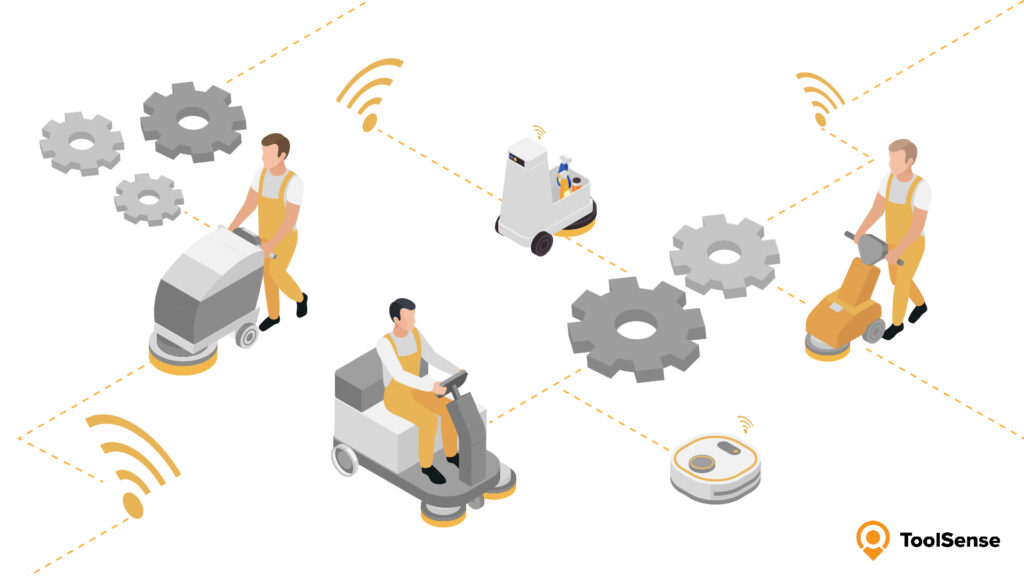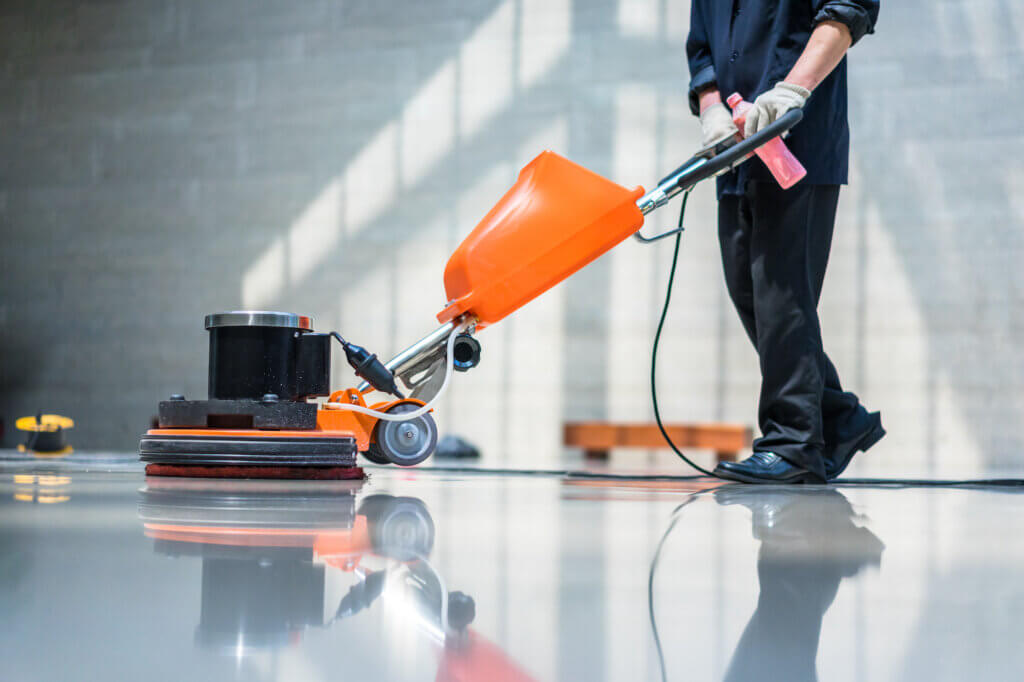Smart Cleaning: Cleaning Industry Transformation
The cleaning industry has been one of the last to develop smart technologies, automate and digitize its offerings. However, the past two years has changed that trajectory. Today, the COVID-19 pandemic has changed the way organizations think about cleaning. Large providers have begun focusing on digitalization in the cleaning industry, responding to heightened awareness and demands from their customers. That likely means the future of the cleaning industry will include digital solutions, an increased reliance on the Internet of Things (IoT), automation and monitoring.

For companies interested in the digital transition in cleaning, it can mean a dramatic shift in priorities and investments in smart cleaning tools and platforms. One of the challenges is the very nature of the industry itself. Until now, the cleaning industry has been labor-intensive, with very few investments in, or the perceived need for, technical solutions. That’s beginning to change as companies of all sizes and across industries look for solutions that optimize their cleaning programs. Digital transformation in cleaning is coming, and those companies that can drive innovation in the cleaning industry will be well-positioned for profits.
Cleaning technology innovations are already appearing. Companies old and new are launching solutions that are driving cleaning industry transformation. In the coming years, the use of robotics, machine-to-machine learning, artificial intelligence, vision technologies and the IoT will drive digitalization in cleaning. While COVID-19 may have been the catalyst for this wave of cleaning industry transformation, it is likely to last. As technology drives improved efficiency and cost reduction, companies will look to use manual labour less and make smarter decisions about how, where and when to deploy machines.
Key Takeaways
- The COVID-19 pandemic has changed the way many companies think about cleaning by focusing more on digitalization in the cleaning industry.
- New technologies include robotics, machine learning, artificial intelligence, vision technologies and the internet of things (IoT).
- Digitalization in the cleaning industry brings many benefits, such as increased efficiency, more informed decisions, and labour savings.
Benefits and Risks of Digitalization in the Cleaning Industry
There are clear benefits to cleaning industry digitalization. From efficiency gains to better-informed decision-making and easier work. The benefits of digital transformation in the cleaning industry are part of the reasoning behind the desire to move rapidly.
ToolSense is trusted by 700+ companies



Benefits of Digitalization in Cleaning
Data Collection and Use
Connected devices, sensors, and cameras can gather extensive data about the usage of spaces. Collecting this data, and pairing it with artificial intelligence programs that can interpret the data, allows for the more efficient use of cleaning. Take, for example, a massive airport terminal. The repetitive and inefficient pacing throughout a terminal to check rubbish bins, soap dispensers and paper towels, along with general cleaning needs, is not the best use of resources. However, sensor data using algorithms that interpret motion data, can deploy staff to the right locations at the right time. Likely resulting in fewer staff hours and expenses.
Value Chain Efficiency
Cleaning technology can drive tremendous efficiency across the value chain. IoT devices, for example, can issue alerts and share data about needed maintenance or issues that require a cleaning crew to be deployed. No longer dependent on visual inspection or verification, companies, and the vendors that supply them, can gain significant efficiencies. For both every-day, routine matters and those that require a specialized solution, technology can be a real difference-maker.
Making Work Easier
Cleaning has never been more in the public eye than during the pandemic. With solutions that limit exposure, provide on-demand cleaning solutions and automate processes wherever feasible, the work of cleaning becomes simpler. Moreover, there is less risk of exposure to harmful substances, including viruses and bacteria. What’s more, facilities teams that can deploy these solutions are able to upskill their workforces, redistributing work and allowing staff to focus on other, more critical or revenue-generating work.
Real-Time Visibility
The digitization of cleaning companies can revolutionize the way facilities are maintained. Facilities can use thermal and contact-less sensors to monitor and measure usage. Data can help those facilities understand usage patterns in real time, and deploy solutions as needed. These solutions also provide a facility’s customers with a sense of the maintenance team’s purpose and intentionality. Combining personal observations with data allows for better communication, problem-solving, and customer satisfaction. Transparency in conversations with tenants and departments helps facilities and housekeeping departments to understand needs. Furthermore, it helps to share strategies for deployment and frequency.
Predictive Cleaning
Driven by powerful algorithms, predictive modelling tools can help with projections for future cleaning needs. These tools can be used at each step of the customer journey. Beginning with the ability to price and quote needed services based on square footage, staffing levels, activity, and visitors. Managers can use these tools to develop historical patterns of use and cleaning needs, resulting in more accurate staffing to respond to surges or lulls in activity, seasonal variances or changes in operations for tenants and customers.
The ToolSense IoT hardware bridges the gap between physical assets and modern software solutions. With our IoT modules, you gain a much more in-depth understanding of your asset’s performance.
Internal Optimization
While the customer-facing benefits are evident, there are internal advantages to digital transformation in the cleaning business. Companies can deploy the same tools to their own internal operations. With sensor data and cameras, companies can better track inventories, ensure that products and supplies are reordered in a timely manner and that issues of theft or fraud are detected early. With connected cleaning carts and equipment, companies can better manage efficiency and usage while ensuring that jobs are done correctly and thoroughly. The transformation of internal operations means companies can reduce costs, improve staffing, and result in smarter planning, resource allocation and scheduling.
Digitalization in Cleaning Risks
With the good news of cleaning operations comes challenges as well. The pace of technology is swift, and companies need to be ready to meet the competitive realities of a shift to digitalization in the cleaning industry.
Increased Capital and Operating Costs
Smart cleaning is not just about deploying a robot to pick up rubbish or clean a toilet. There are no guarantees or maintenance-free solutions available, whether using technology or people. Tools need to be upgraded, with hardware and firmware maintained, protected and revised regularly. The costs of purchasing, deploying and maintaining these tools could be considerable and prohibitive for some businesses.

Staff Displacement
As with many technological advancements, there’s a real risk that the solutions will displace people, resulting in job loss at a time when those in low-income jobs are often the most vulnerable. However, the pandemic has caused many to leave even low-paying jobs and those considered riskier from a public health perspective. There is an opportunity within this evolving reality. Companies can consider retraining and upgrading remedial cleaning jobs, allowing employees to gain new technical skills and work alongside some of the new technologies.
Impact on Low-Cost Markets
The technologies used in smart cleaning are evolving at a rapid pace. Those changes can keep some companies from pulling the trigger on technical changes. The capital expenditures required for some of these technologies is considerable. Some companies may consider creating Cleaning-as-a-Service solutions that do not require the capital outlays that would drive some away from more expensive options. These as-a-service models will likely allow for lower, operationally centred costs and deliver a better ROI for customers.
Sign up now to access the latest market insights and improve your asset operations efficiency.
Is the Cleaning Sector Ready for the Digital World?
With the operational and financial benefits evident, one question remains. Is the cleaning industry ready for a digital revolution?
Again, we can look to the pandemic for clues. While digitalization has come to many industries, the COVID-19 crisis put cleaning in the crosshairs. The increased awareness may help to drive change at each level of the industry.
As the digital changes evolve, companies providing smart cleaning will benefit from solutions that include clear and simple training, easy-to-understand web portals and ample customer support.
How will companies convince customers to adopt new technical solutions? Here are several ways:
Business Streamlining
Demonstrations, either on-site or at a trade show, are a powerful way for potential customers to see for themselves the benefits of these technologies.
By showing the ways, these tools can streamline business operations, whether through vehicle tracking or smart machines, prospective customers can apply the benefits to their own business.
Other ways to demonstrate that impact include showing how dashboards, data and feedback can help fine-tune a site’s use of the technology.
Technical Knowledge
Facilities executives likely already have some technical knowledge, coupled with strong understanding of their company and its industry. Tech-savvy customers are more likely to see the benefits from the beginning and may be craving technologies that let them get work done faster and cheaper. Case studies can point out the real benefits of adapting new technologies and how they can be used safely and effectively with existing cleaning staff.
Online Learning
Another way to combat the potential loss of staff positions is to empower those who will be working with these technologies. Consider how to provide e-learning options and certifications in the new technologies. These options, at little cost to you or the customer, can help strengthen the skill set for employees, leading to improved staff retention and morale. Learning modules that can be accessed on mobile devices or desktop computers help meet workers where they are.
Behavioural Changes
Changing long-practiced behaviours can be a challenge and could be a source of resistance, by managers and staff alike. However, increased competition, rising expectations and the cost of labour will help propel these changes along. That reality is especially true when senior leaders see the gains in efficiency and cost-savings that can occur.
The key is to focus on what businesses will gain from adopting your technologies.
ISS Austria
„We wanted to have a solution that does not only track expensive assets but also cheap ones. In Austria, ISS operates over 6,500 cleaning machines alone, without even counting vacuum cleaners and other pieces of equipment. With ToolSense we bring them together on a single platform, leveraging data from IoT hardware and improving maintenance and inspection processes.“

ISSA Study: How the Cleaning Industry Is Approaching Innovation
A recent cleaning industry analysis by the International Sanitary Supply Association (ISSA) shows that digitalization is top of mind among many industry leaders. While the study was completed just before the onset of the COVID-19 pandemic, the urgent needs expressed are resonant even with the changed reality brought on by the health crisis. Among the findings:
- Digitalization and robotics are the top priorities for future discussion and investment.
- Digital products and solutions are already considered to be in use while robots were seen as a future area of implementation.
- Robotics is seen as going hand in hand with advancements in automation.
- Sustainability is a priority across the industry and is perceived to be gaining more importance in coming years.
- Staff shortages and skills are a major challenge.
- Executives are looking for ways to optimize controlling processes to deliver more quality cleaning results.
Final Thoughts on Digitalization in the Cleaning Industry
The future of cleaning is digitalization. Cleaning industry trends point clearly in that direction, with the benefits of technical solutions and their customers abundant.
At ToolSense, we help customers across industries with machine and service management solutions. Our digital solutions include asset management, damage notifications, documentation and service reminders. Our IoT tool solutions build your connected network with performance data to optimize your investment.
Learn more about how ToolSense can help transform your cleaning solution. Try ToolSense for free for 14 days and see how it can change the way your cleaning gets done.
FAQ
Digitalization is transforming the cleaning industry toward more smart technologies, automation and digitized offerings.
The 4 main areas are technology, data, process, and organizational change.
The main benefits are in data collection and use, value chain efficiency, workflow simplification, real-time visibility, predictive cleaning and internal optimization.
Digital transformation is the process of using digital technologies to create new, or change existing, business processes, culture, and customer experiences to meet changing business and market demands.

